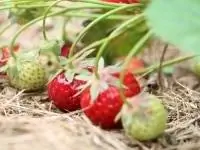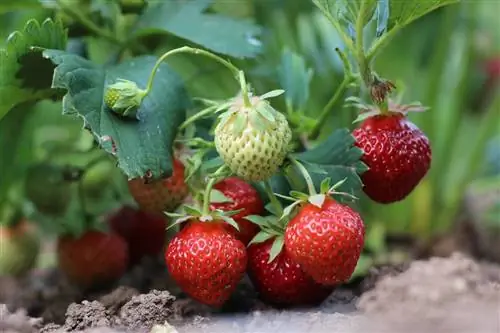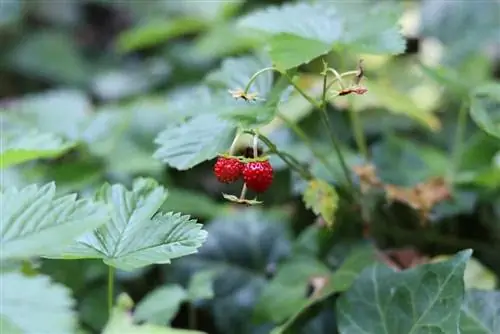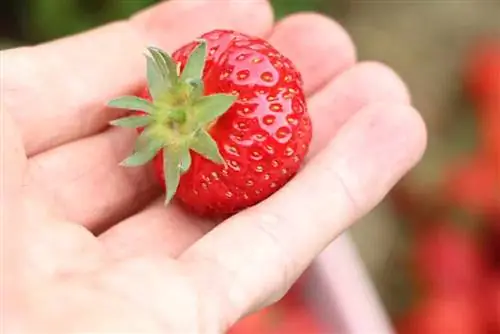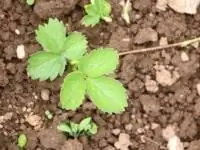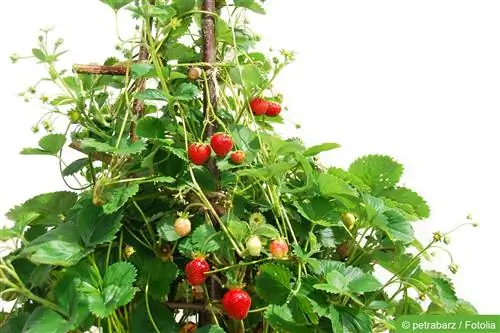- Author admin [email protected].
- Public 2023-12-17 03:39.
- Last modified 2025-06-01 06:48.
The strawberry is the optimal starting fruit for “self-sufficiency from the balcony” - a few balcony strawberries cover half the family’s fruit supply if the “balcony planting space” is expanded a little into three dimensions with hanging baskets and pots. If complete self-sufficiency is not an issue, we recommend the best varieties of balcony strawberries to satisfy your sweet tooth in a he althier way than usual for several years with little care and easy overwintering:
Planting balcony strawberries
Strawberry plants are planted outdoors in summer, preferably in August. The motto for the patient outdoor gardener is to let them take root in peace and remove the flowers that appear in the year of planting so that the strawberries can get going with full force in the next season and produce an early and magnificent harvest.
In practice, we (unfortunately?) don't all live in the country anymore, so: The ideal planting time for balcony strawberries is spring, because city dwellers are even more depressed by long, dreary winters than country dwellers have a little green around you even in winter. In spring, city dwellers usually show a he althy and urgent urge to spend time in the fresh air, so balcony plants come in handy; In addition, it makes little sense for him to plant strawberries in late summer in order to overwinter them soon afterwards. In spring you have the choice when it comes to strawberry plants:
1. Early strawberry potted plants with root balls are available just in time for the start of the balcony season. A little to wear if there is a large balcony to plant, but the safest option; also for difficult balcony areas and inexperienced balcony gardeners.
It is planted in April/May, and in the same year you can expect the first harvest, which will produce a smaller amount of fruit (if you do not plant annual “one-off” strawberries; strawberries will bear in the second season best, some old varieties even in the third or fourth season).
2. Specialist retailers offer “strawberries from the freezer”, so-called strawberry frigo plants, which are shipped from March to September. These frigo plants are normal strawberry plants that are cleared November to February and kept in artificial hibernation at minus 2 degrees.
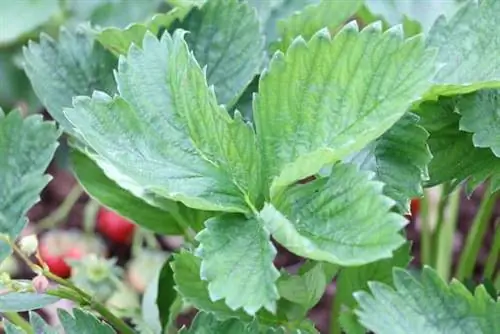
The plants thaw during shipping, so the shipping time corresponds to the ideal planting time. The advantage of these “frozen strawberries” is that they are “frozen” when they are well developed and produce the first harvest just 8 to 10 weeks after planting. Here too, however, there is initially a smaller amount of fruit, the strawberries only come into their own in the following season (dealers with frigo plants certainly also have annual “harvest miracles”, but they are not known as taste miracles).
Strawberries want to be planted in loose, nutrient-rich substrate, e.g. B. good peat-free organic soil from stores. It is already pre-fertilized, but can be enriched with organic fertilizers that cannot be overdosed (recommended, for example, if you want to plant the strawberries closer than required due to limited space). City children with contact with the countryside plant their strawberries in soil they brought with them, real soil with a high humus content and nutrients from mature compost mixed in. If you enrich soil/substrate, this should be done at least two weeks before planting.
The balcony boxes with the strawberries should be exposed to the sun for several hours a day, only then will the fruits develop a rich red color and all other he althy and delicious ingredients - right up to the high fructose content, which gives the strawberries their special aromatic sweetness. Strawberries also need a location where they grow protected from strong wind and rain, on the balcony usually guaranteed by the surrounding buildings. Strawberries do not want to experience waterlogging, balcony boxes and other containers must either offer enough space or an efficient drainage made of gravel or pottery shards, the soil should be (partially) replaced in good time if there is a tendency to compaction.
If you plant several strawberries next to each other, a planting distance of around 20, 25 cm is sufficient in the balcony box. Larger boxes/pots are equipped with around five plants per square meter. Before planting, immerse the roots in water for a few minutes; the pot ball must be sufficiently moist down to the ground. When you plant the strawberries, the "plant heart" should lie exactly above the soil surface (this famous heart of the strawberry, which must remain intact when pruning, for example, is nothing other than the central middle of the plant, where the shoots come together and small leaves can be seen - this is where all the strawberry growth starts). The bale is now lightly covered with soil, pressed firmly and watered well. Strawberries are usually delivered with strong roots and grow quickly; they should not have to suffer from dryness during rooting.
Care for balcony strawberries
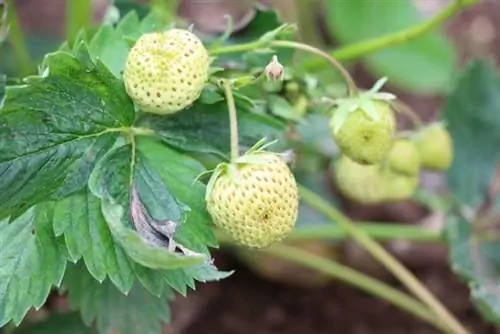
The first flowers and fruits will soon be visible. The more flowers and berries a strawberry plant has, the faster the initially provided nutrients are used up - strawberries should be fertilized regularly during the growing season, among other things for taste reasons with one from the plant organic fertilizer available as needed. You can do wrong with the few, once-bearing strawberries may receive another nutrient replenishment at the beginning of flowering, always-bearing strawberries until the end of the season, depending on their vigor and yield, receive a little fertilizer up to once a week. Wild strawberries should, if possible, get the nutrients from the substrate over the season because fertilizer applications quickly influence the taste of the fruit. You can find out details on the correct nutrient supply for strawberries in the article “Fertilize strawberries correctly”.
The water supply must be correct and sufficient right from the start, especially in the four weeks from the first flowering to the harvest, strawberries can be quite thirsty (and always-bearing strawberries in hanging baskets or pots evaporate so much that they are… Sun “drink” up to 1 liter per day per pot. Always water so that the fruits (and therefore most of the leaves) remain dry, this protects against fungal attack.
If the strawberry plants develop new runners, you should always cut them back immediately in the first few years, because they weaken the plants and harvest (when the strawberry plants reach the end of their lifespan, i.e. produce significantly fewer fruits, you can use these runners Use breeding of the next generation). Some strawberry varieties develop fruit in large quantities and in bunches, so you should cut away one of the bunches that grow on top of or into each other.
Tip:
If you put some expanded clay, wood shavings, straw or commercial strawberry ripeners (a kind of plastic lattice collar) around the roots in early summer, you can not only harvest clean strawberries, but you can also provide a little prevention against fungal infestation. because the strawberries dry faster after rain.
Overwintering balcony strawberries
With the good care just described, strawberries produce productive harvests for at least three years, but the old cultivars in particular are often productive for much longer.
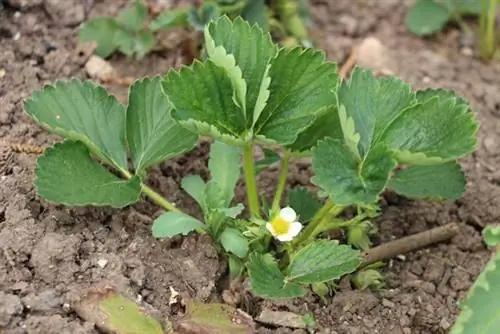
So the strawberries have to overwinter on the balcony, basically no problem for a strawberry plant, not even on the balcony. Even outdoors, strawberry plants do not extend their roots into the ground into the frost-free zone, so they cannot be missing from the balcony box. Break in late autumn if necessary. Remove the last inflorescences, cut off the outermost dried leaves and tendrils; the heart of the strawberry remains intact (with a generous diameter). Cover the balcony box so that the ground surface does not freeze; Depending on the location, if you have warm, built-in city balconies, it is enough to ensure a clean harvest with a layer of expanded clay. Towards the end of winter you can improve the trimming and cut out any remaining dried leaves/vines right up to the heart.
Don't be afraid of the "growth inhibitors in strawberry leaves" that are currently floating around in the media, which are said to cause the next harvest to fail if you don't cut strawberries down to three heart leaves immediately after harvesting. It may be that during biological studies researchers have found hormonal inhibitors in strawberry leaves, which, together with many other plant substances (in the case of the better-researched apple, there are 30 to 3,000 plant substances, depending on the source and context), are relocated to the rootstock when the plant moves in in the fall and has an unfavorable effect on its own flower formation for the next year.
The relevant reports do not provide the reader with any evidence, so it cannot be checked whether these inhibitors are actually formed against food competitors and, as a result, cause a certain amount of self-damage; whether they are formed as self-protection after excessive fruit development (harvest) so that “things run more normally in the next season”, or whether they simply self-regulate and stop the flowering that starts in summer in a self-regulating and planned manner in late autumn.
Such research results taken out of context are poor basis for recommendations; However, we have known for a long time and with certainty that the autumn intake of nutrients helps the plant and that old leaves that are not cut away warm the plants in winter and keep the soil moist. The absolutely convincing argument that a strawberry plant's own leaves do no harm if they are still on the plant in September or later is the common sales practice of early strawberries by the end of September (see Spargel-Erdbeeren Springensguth GbR at www.erdbeeren.de/shop/info-hilfeseite), everyone wears them the following season.
In spring, the mother plants sprout freshly and begin to bloom. In the case of strawberries that form runners, the first new tendrils appear after the first flowers (which are cut away or tied up). Single-bearing strawberries can also use a little starter fertilizer (always bearing anyway), and regular watering can begin at the same time. The flowers turn into fruit, and a little later it's time to say bon appetit!
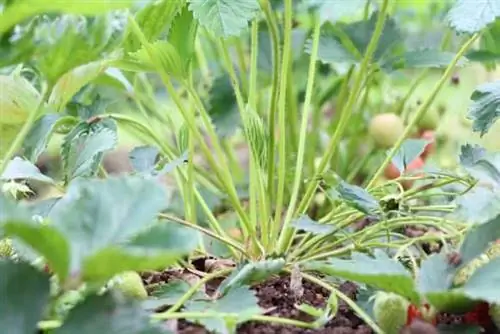
How good the taste is that satisfies the strawberry appetite depends on which type of strawberry you choose:
Modern cultivated varieties: garden strawberries for balconies and terraces
A significant proportion of a modern plant producer's customers live in city apartments without a garden. These customers want plants that can grow in the limited root space that balcony boxes or patio pots have to offer. Due to the numerous food scandals of the past few years, there are increasingly more crops in which the strawberry, as the Germans' favorite fruit, of course has to be included.
The “stars of the season” (‘Loran F1’, ‘Rosana® F1’) and many other new and newest cultivars of garden strawberries for balcony cultivation are offered in the garden center etc. But the modern cultivars not only have advantages (you can find out more about the disadvantages under “Propagate strawberries”), for example the strawberry is also one of the fruits that has been (partially, sometimes completely) freed from its typical taste in commercial fruit farming.
You can still be sure that outdoor cultivation produces real flavor bombs compared to industrial greenhouse cultivation, but gourmets sometimes doubt the “wonderful” or “very fine” aroma of the commercially grown varieties. Fortunately, as a balcony gardener you have many more exciting options:
You make the balcony strawberry
At least 90% of the 1,000 garden strawberry varieties do not belong to the area of “modern commercial plant breeding”, but were created through patient, selective breeding as little changed varieties full of the original strawberry taste. The only reason they are not recommended for cultivation in balcony boxes/patio containers is because they also show the original growth of a strawberry, including the usual lively production of runners for the purpose of vegetative propagation.
It doesn't have to bother you at all. In the balcony box you can see the foothills before they have taken on such a clear shape. If they are pinched off or cut off, the mother plant can put all of its energy into the much sought-after strawberries. When the mother plant is exhausted, they are no longer cut off, but instead provide the next strawberry plants (by potting them with the first roots) - probably the reason why the delicate strawberry runners are portrayed in commercial magazines more like some kind of rampant zombies: If If a plant constantly produces its own successors, this significantly slows down plant sales.
When choosing a cultivar for balcony cultivation, only one thing is important: that the cultivar grows as compactly as possible so that half the balcony is not covered in strawberry greenery. Otherwise you can choose from the full range; If you are thinking about seed propagation/breeding, the seeds must be “varietal proof”. In aromatic nurseries and organic nurseries that are run with passion and knowledge, you can get e.g. B. the following interesting old strawberry varieties, which also fit very well on a balcony:
- Fragaria x ananassa 'Dresden Scented Strawberry' is just about the size of a balcony, but the strawberry scent + highly aromatic fruits are definitely worth living "with a little green on the balcony."
- Fragaria x ananassa 'Macherauchs Marieva' delivers deliciously fruity strawberries even for allergy sufferers.
- Fragaria x ananassa 'Mara de Bois': Get the top variety of French dessert strawberries directly from your own balcony? Why not, it's just a strawberry plant.
- Fragaria x ananassa 'Ostara', old balcony-tested variety with high yields of fully aromatic strawberries.
- Fragaria x ananassa 'Rote Karlsbaderin' brings the strawberry meadow to the balcony, which lasts from June to frost.
Tip:
For “balconies” you can also look at the cultivars of other strawberry species. Long-bearing cultivars of wild strawberries are specifically offered as balcony strawberries, but these monthly strawberries are hardly intended to impress in terms of taste
(there are no reviews yet for the brand new “Balcony Strawberry Fontaine” made from Fragaria vesca and a Japanese wild strawberry). Balcony cultivation of suitable varieties of musk strawberries ('Bauwens', gourmet variety 'Profumata di Tortona', pollinator 'Captron Royale' is suitable as a pollinator for both) or scarlet strawberries ('Little Scarlett') should be more rewarding in terms of taste.

